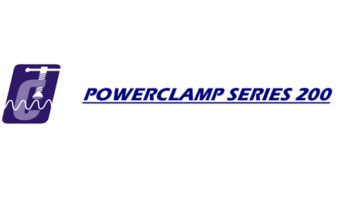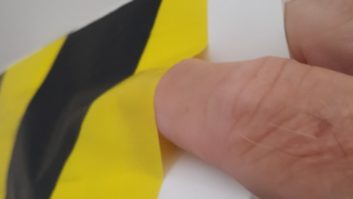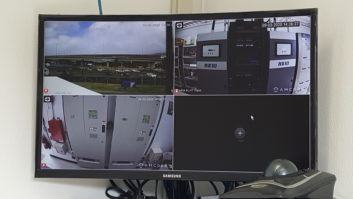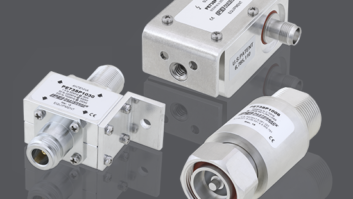(click thumbnail)Fig. 1: ‘Tis the season.There are many ways to protect your studio and transmission equipment from lightning. Some methods, such as proper grounding, are not expensive yet yield good results. If you don’t have surge suppression at your studio and transmitter site, make it a priority.
No budget? Check with your station’s insurance agent; many insurance companies will pay for some or all of a surge suppressor because of the asset protection the device offers. Even if the insurer won’t help, once a surge suppressor is installed, ask for an adjustment in premiums. An anti-theft device will lower your car insurance; similarly, if you take steps to reduce or eliminate claims due to lightning by installing a surge suppressor, you shouldn’t pay the same premium as an unprotected station.
If you plan surge protection for your station, a good place to start is LEA International. Carol Rassier demonstrated a new surge suppression system designed especially for AM and FM stations at the NAB show. Shown in Fig. 2, the Dyna-System DS21S is a series-connected suppressor, designed for critical loads. Don’t jump to conclusions, like I did, that you wouldn’t want a series suppressor.
For as long as I can remember, parallel suppressors were the product of choice; if one of the modules blew, because the suppressor was in parallel with the AC feeder, the “protection device” wouldn’t take you off the air. Also appealing: the parallel suppressors were cheaper.
(click thumbnail)Fig. 2: The new LEA Dyna System DS21S provides improved protection against surges.
Carol points out that the parallel suppressors usually have fuses, which are current-limited. The parallel devices also have a turn-on or response time for the protection module to actually turn on and “clamp” the surge. Inevitably, some of the surge could get through.
In a series suppressor, there are no fuses; and though the modules are in parallel to the AC line, power flows through them all the time. There is no turn-on time, so the result is faster response. Although the suppressor box is in series with the AC feeder, the individual modules are in parallel. Should a module sacrifice itself, the feeder will not be taken down.
The new DS21S has two protection modules per phase, so if one is sacrificed, you’re still protected. LEA International can provide suppressors with up to four modules per phase for really critical applications.
Perhaps the best feature of the DS21S is its price. Series suppressors have been traditionally more expensive than their parallel counterparts. The DS21S lists for $3,800 and is available through your favorite broadcast supplier.
Want more information? Head to www.leaintl.com or e-mail Carol Rassier at [email protected].


. . .
I met John T. M. Lyles more than 20 years ago when we worked at Delta Electronics. John went on to Broadcast Electronics, where he left his mark on several of its transmitter products. For more than a decade, John’s been with the Los Alamos National Laboratory, working in the Neutron Science Center.
An avid Radio World reader, he saw our discussion of rebuilt vs. new tubes and weighed in. Fig. 3 is from John’s lab Web page.
(click thumbnail)Fig. 3: John T. M. Lyles with high-power rebuilt tube stock.
He and his staff received an internal award for savings of material and money for rebuilding tubes. Burle (RCA) had been rebuilding the big RF triode and tetrode tubes. The center’s staff now rebuilds most of its own 4CW250,000B and 4CX3000A tetrodes. The power tubes are used to support the linear accelerator projects at the center. The rebuilding saves not only taxpayer money, but time; some custom tubes require up to a year to build, seriously disrupting experiment schedules.
A side benefit is that, during rebuilding, one can often determine the cause of the failure. This data has been invaluable to the researchers at the Science Center.
About 500 pounds of hazardous waste per year is avoided by recycling the tubes, at a cost savings of about $100,000 per year. A hundred grand is quite a tube budget!
John can be reached at [email protected].

. . .
Stu Tell writes that in all his years in broadcasting, he would always use rebuilt tubes. The biggest reason was to save the management money (so they could complain about him over-spending somewhere else, Stu adds.)
At one station, Stu was maintaining a Gates FM2.5H3. This little transmitter was a joy, except when he had to change the final. For Stu, it was a job of two to three hours, tuning and re-tuning – basically a long struggle to get it to give its licensed TPO with decent efficiency.
Once, when the final was dying, Stu called his rebuilder and asked them to send a tube. They said they couldn’t because they had none in stock. There was a shortage of 5CX1500s at the time.
The station decided to order a new tube from Harris. It arrived; Stu installed it and pressed the plate “on” button. The first thing he noticed was the FWD power meter needle was all the way over to the right. This happened even with low screen current. He’d never seen this before with this transmitter.
It took only a little tuning and the rig was running with about the same readings that were on the factory test sheet. Stu had never adjusted the convenient front-panel FWD power calibration pot until now. He had to; the reading was pegged to the right at 120 percent. With no dummy load or Bird Wattmeter, the best he could do was to use the indirect method and adjust the meter accordingly.
The experience told Stu that the transmitter probably was not putting out all the RF it was supposed to with the various rebuilts used before. Somebody along the way just gave up and calibrated the power meter to show what power output they arrived at using the indirect method.
Since, Stu is sold on using new tubes. It got him thinking about all those times when he called various manufacturers’ field service departments complaining about efficiency and power output problems. The field service rep would always ask if he had tried a new tube. Stu’s reply was, “I have a installed a fresh rebuild.” At that point they would usually pause, probably so they could roll their eyes.
In summary, if you use rebuilt tubes, specify the transmitter in which they will be used. And if you still have problems, try a new tube, even if borrowed from another station, just to prove that the problem isn’t elsewhere in the transmitter.
Stu Tell can be reached at [email protected].
Submissions for this column are encouraged, and qualify for SBE recertification credit.










